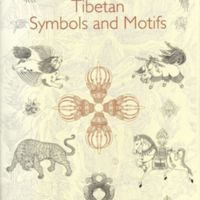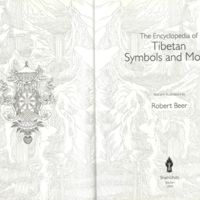The Encyclopedia of Tibetan Symbols and Motifs
Dublin Core
Title
The Encyclopedia of Tibetan Symbols and Motifs
Creator
Robert Beer
Publisher
New York : Distributed in the United States by Random House
Date
1999
Table Of Contents
1. Landscape elements : Rock formations ; Simulacra in landscape ; Water ; Fire (flames) ; Air (clouds) ; Sky ; Rainbows ; Aura lines -- 2. Flowers and trees : The lotus ; Lotus seats or thrones ; Flowers, flower buds, and leaves ; Trees, leaves, and fruit roundels -- 3. Animals : Animals mythological and real ; The windhorse and the four supernatural animal ; Guardians of the four directions ; The dragon ; Garuda ; The makara ; The face of majesty ; The Naga ; The three victorious creatures of harmony ; Domestic and wild animals ; Tiger, leopard, snow-lion and horse ; The elephant ; Deer ; Birds ; The six-ornament throne of enlightenment ; The animal thrones of the five buddhas ; The five buddha families: colours, origins, and contradictions -- 4. Narrative subjects : The four friends or harmonious brothers ; The six symbols of long life ; Diagram of shamatha meditation practice or 'tranquil abiding' -- 5. Cosmology : Mount Meru ; The Vedic legend of the churning of the ocean ; The mandala offering ; The Tibetan astrological diagram ; The 'all-powerful ten' interlocking syllables ; The stupa ; The channel-wheel systems -- 6. Mudras -- 7. The chakravartin and his seven precious possessions : The seven possessions of the chakravartin ; The seven secondary possessions of the chakravartin -- 8. Auspicious symbols : The eight auspicious symbols ; The eight auspicious substances ; The five offerings of sensory enjoyment -- 9. Various peaceful offerings, jewels, and ritual implements : The three jewels ; The seven water bowl offerings ; Jewels ; Gzi stones or beads ; The rosary ; Hand-held plant attributes ; Assorted ritual implements ; The possessions of an ordained monk ; Monastic and ceremonial musical instruments -- 10. The wheel of sharp weapons : The vajra ; The crossed vajra ; The bell ; The ritual dagger ; The Hindu kapalikas, padmasambhava, and the Buddhist mahasiddhas ; The eight great charnel grounds ; The Hindu rite of cremation ; The tantric staff ; The hand drum ; The thighbone trumpet ; The curved knife or chopper ; The skull or skull-cup ; Hand-held weapons and the ritual implements of specific deities ; Archery ; The bow ; The arrow ; The sword ; The trident-pike, caduceus, dart, and other bladed weapons ; The spear, lance, javelin, harpoon, and pike ; The trident ; The club ; The snare, noose or lasso ; The iron chain ; The shield ; The discus ; The axe ; The elephant goad or iron hook ; Miscellaneous ritual implements and weapons -- 11. Wrathful offerings, tormas, and ritual fire hearths : Dismembered body parts and other wrathful attributes ; Flayed skin friezes of wrathful offering assemblies ; The eight attires of the charnel grounds ; The six bone ornaments and the five-skull crown ; Ritual offering cakes and thread crosses ; The wrathful offering of the five senses ; The inner offering ; An assembly of weapons and wrathful offerings ; The ritual fire offering -- 12. Geometric borders, patterns, designs, and motifs.
Text Item Type Metadata
Original Format
Book
Citation
Robert Beer, “The Encyclopedia of Tibetan Symbols and Motifs,” Humanities Hub, accessed December 28, 2025, https://humanitieshub.sdsu.edu/omeka/items/show/1896.


